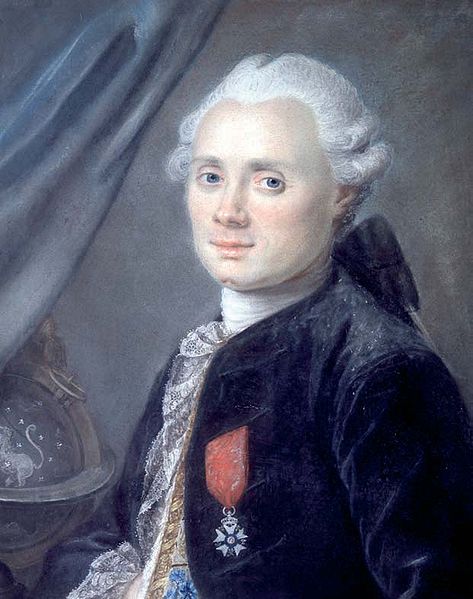<Back to Index>
- Astronomer Charles Messier, 1730
- Writer Pearl Sydenstricker Buck, 1892
- 6th President of Argentina Bartolomé Mitre, 1821
PAGE SPONSOR

Charles Messier (26 June 1730 – 12 April 1817) was a French astronomer most notable for publishing an astronomical catalogue consisting of deep sky objects such as nebulae and star clusters that came to be known as the 110 "Messier objects". The purpose of the catalogue was to help astronomical observers, in particular comet hunters such as himself, distinguish between permanent and transient objects in the sky.
Messier was born in Badonviller in the Lorraine region of France, being the tenth of twelve children of Françoise B. Grandblaise and Nicolas Messier, a Court usher. Six of his brothers and sisters died while young and in 1741, his father died. Charles' interest in astronomy was stimulated by the appearance of the spectacular, great six - tailed comet in 1744 and by an annular solar eclipse visible from his hometown on 25 July 1748.
In 1751 he entered the employ of Joseph Nicolas Delisle, the astronomer of the French Navy, who instructed him to keep careful records of his observations. Messier's first documented observation was that of the Mercury transit of 6 May 1753.
In 1764, he was made a fellow of the Royal Society, in 1769, he was elected a foreign member of the Royal Swedish Academy of Sciences, and on 30 June 1770, he was elected to the French Academy of Sciences.
Messier discovered 13 comets. The first version of Messier's catalogue contained 45 objects and was published in 1774 in the journal of the French Academy of Sciences in Paris. The final version of the catalogue was published in 1781, in Connoissance des Temps for 1784. The final list of Messier objects had grown to 103. On
several different occasions between 1921 and 1966, astronomers and
historians discovered evidence of another seven deep - sky objects that
were observed either by Messier or his friend and assistant, Pierre Méchain, shortly after the final version was published. These seven objects, M104 through M110, are accepted by astronomers as "official" Messier objects. The objects' Messier designations, from M1 to M110, still are in use by professional and amateur astronomers today. The catalogue is not organized scientifically by object type or by location, as the later New General Catalogue would
be. Nonetheless, the Messier catalogue comprises nearly all the most
spectacular examples of the five types of deep sky object -- diffuse nebulae, planetary nebulae, open clusters, globular clusters and galaxies -- visible from European latitudes. Because these objects could be observed with the relatively small aperture refracting telescope (approximately 102 mm, or four inches) used by Messier to study the sky, they are among the brightest and most attractive deep sky objects observable
from earth, and are among the most popular targets for visual study and
photography available to modern amateur astronomers using larger
aperture equipment. Furthermore, almost all of the Messier objects are
among the closest to our planet in their respective classes, which
makes them heavily studied with professional class instruments that
today can resolve very small and visually spectacular details in them.
Professional astronomers still often refer to these structures by their
Messier designation. Many of the objects in the Messier catalogue were discovered by his assistant, Pierre Méchain. The crater Messier on the Moon and the asteroid 7359 Messier were named in his honor.